5 Poisonous Plants That Can Be Used As Medicine When SHTF
The line between medicinal and poisonous plants is very thin. Sometimes the very thing that heals you can kill you if you consume too much of it. And that is as true of pharmaceuticals as it is for plants.
But over time, we have become convinced that a chemical synthesized in a lab is safer than a plant that grows in nature.
However, a trained herbalist knows how to use poisonous plants in the same way a doctor knows how many pills to tell you to take. That’s why I trust this guide. It’s not an ordinary survival book—it’s a practical resource that teaches the age-old wisdom of healing. So, when you’re planning your escape, make sure this handbook is in your backpack. It could be your key to staying safe when everything else goes wrong.
Always use extreme caution when dealing with poisonous plants because many, if used improperly, can cause death!
Foxglove
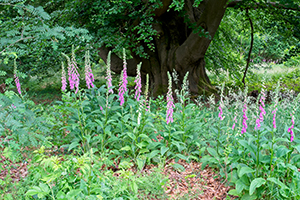 Foxglove, Digitalis purpurea, always comes to mind first when I think of poisonous medicinal plants (probably because I read a lot of murder mysteries when I was young). A common garden plant, foxgloves are grown for their beautiful flowers despite their deadly reputation.
Foxglove, Digitalis purpurea, always comes to mind first when I think of poisonous medicinal plants (probably because I read a lot of murder mysteries when I was young). A common garden plant, foxgloves are grown for their beautiful flowers despite their deadly reputation.
All parts of the plant are toxic, and you can feel the effects even if you ingest just a small amount of the plant. Symptoms include nausea, vomiting, and diarrhea.
However, the same toxic compounds can also be used medicinally. These compounds are called glycosides. The glycosides present in foxglove are called digitalis, after the Latin name of the plant.
Survival Uses
Traditionally foxglove was used to treat dropsy, now known as edema, a swelling condition related to cardiac problems. Nowadays, digitalis is still extracted from foxglove leaves and used to make heart medicine.
When SHTF and there aren’t any pharmacies or doctors, foxglove can be used with extreme caution to treat heart problems. While accidental death is uncommon, it is possible.
Tansy
Tansy, Tanacetum vulgare, is another common garden plant with a nefarious reputation.
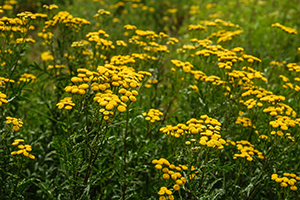
Featuring fragrant ferny leaves and bright yellow flowers, it is easy to see why tansy is popular. Like foxglove, it was once commonly used in herbal medicine to treat many ailments, including worms, nausea, and kidney problems. But over time, its toxic nature led people to look for safer choices.
While you can eat the leaves in small amounts, large amounts of tansy can be deadly, so use caution. The essential oil it contains is considered toxic.
However, medicinal tansy can be used externally for sprains and bruises or as an herbal wash. Simply brew an infusion of the leaves and flowers. You should always spot test with tansy first as it can cause skin irritation in people.
New Field Guide Makes It Easy To Discover Backyard Remedies
You’ll find 800+ beneficial plants and remedies in “The Lost Book of Herbal Remedies”, recipes of tinctures, teas, decoctions, essential oils, syrups, salves, poultices, infusions and many other natural remedies that our grandparents used for centuries. What is unique about this book is that we’ve been able to select only the ones proven to have a powerful effect.
What’s also special about this book is that it has between 2 and 4 high definition, color pictures for each plant and detailed identification guidelines to make sure you’ve got the right plant. Get your physical book HERE!
Medicinal Uses
Tansy should only be used externally. You can make a poultice with fresh tansy leaves to alleviate swelling from sprains and aid wound healing.
However, tansy can cause contact dermatitis so use caution and test a small area of the skin first.
Yellow Dock
Yellow Dock, Rumex crispus, also known as curly dock, is a common wild edible. People forage for leaves to eat and use the root medicinally. The root can be boiled and used to detox, treat liver ailments, and as a laxative.
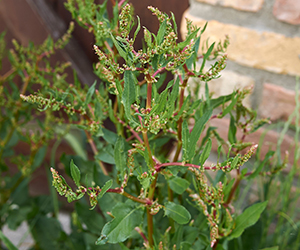
But this useful plant has a dark side as well.
The leaves contain oxalic acid, which can be poisonous when consumed in large quantities. You can eat a few leaves raw, but you should cook them if you plan to eat more than a few.
Cooking will reduce the amount of oxalic acid in the leaves.
Consuming too much oxalic acid can lead to severe mineral deficiencies—especially a deficiency in calcium. Calcium deficiency can cause fatigue, seizures, and confusion.
Dock Infused Oil for Itching
- Fill a jar ¾ of the way with fresh, dry dock leaves. Make sure you use only healthy, undamaged leaves.
- Cover your leaves with a carrier oil, like olive, sesame, or coconut oil. Make sure your leaves are completely covered and close the jar.
- Leave the jar undisturbed in a sunny window for 4-6 weeks. Then strain the leaves and place the oil in a clean jar.
- You can apply the oil as is to relieve itching or add it to salves or balms.
Castor Beans
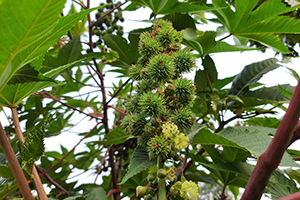 Castor Oil is a popular traditional remedy for constipation. Its antibiotic, antifungal qualities make the oil excellent at relieving skin irritations, acne, and fungal infections.
Castor Oil is a popular traditional remedy for constipation. Its antibiotic, antifungal qualities make the oil excellent at relieving skin irritations, acne, and fungal infections.
It also makes a wonderful oil choice for a base for medicinal salves and balms. But this magical oil comes from a deadly plant.
Castor oil comes from pressing the hulled beans of the castor plant, Ricinus communis. It is essential to remove the outer shell or hull of the bean before use.
The hull contains ricin, which is a deadly poison. Ricin is so toxic that it can kill an adult who has chewed as few as 1-6 beans!
Once you remove the shell, the beans are safe. However, castor oil should not be consumed for long periods of time as it can lead to a potassium deficiency. It should also be avoided by pregnant women unless they are full-term and looking to induce labor.
Castor Oil
- For constipation: Take ½ an ounce of castor oil to relieve constipation. You can mix the oil with juice to improve the flavor. You should notice the effects in about 2-3 hours though it may take as long as 6 hours. However, you should avoid taking castor oil before bed.
- For skin: You can apply castor oil topically to help alleviate a number of skin conditions. It can help with wound healing, acne, and moisturize your skin.
Stinging Nettles
Poison comes in many different forms, and not all of them are deadly.
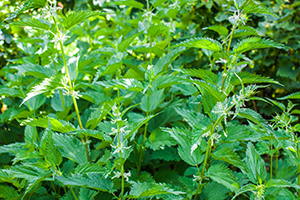
Stinging Nettles, Urtica dioica, is a prime example of a non-deadly poisonous plant with many medicinal uses.
As the name suggests, when you touch these nettles, you experience contact dermatitis. Which is really just fancy for saying it gives you a rash.
But that means you don’t want to consume stinging nettle raw. Just imagine all those stinging hairs in your throat. When you cook the leaves, you neutralize all the toxins. Then you can add these nutritious leaves to your food or use them medicinally.
Nettles can help treat pain and inflammation, hay fever, lower blood pressure and blood sugar, and aid in healing wounds. You can simply add a cup of delicious nettle tea to your daily routine to get the health benefits of this poisonous plant.
Nettle Tea
- 1 cup of fresh nettles
- 2 cups of water
- Honey or another natural sweetener to taste
Boil two cups of water. Add the nettles. Allow the nettles to steep for between 5-15 minutes, depending on the strength you want. Strain the nettles. Add your sweetener. Then enjoy!
Final Thoughts
When dealing with any medicine, herbal or pharmaceutical, it is important to use caution. Often the line between potent and toxic is very thin. However, when used with care, these poisonous plants can be lifesaving.
Thorough knowledge of plant medicine will be essential in order to survive when SHTF. Without doctors and pharmacies, we will once again need to rely on what nature can provide for us.
again need to rely on what nature can provide for us.
Being able to identify common plants like yellow dock and stinging nettles can help you cope with common ailments. Learning to masterfully brew infusions of foxglove comes with time and study.
In the end, nature provides us with what we need to survive. We just need to be open enough to see it.
Anyone can join.
Anyone can contribute.
Anyone can become informed about their world.
"United We Stand" Click Here To Create Your Personal Citizen Journalist Account Today, Be Sure To Invite Your Friends.
Humic & Fulvic Liquid Trace Mineral Complex
HerbAnomic’s Humic and Fulvic Liquid Trace Mineral Complex is a revolutionary New Humic and Fulvic Acid Complex designed to support your body at the cellular level. Our product has been thoroughly tested by an ISO/IEC Certified Lab for toxins and Heavy metals as well as for trace mineral content. We KNOW we have NO lead, arsenic, mercury, aluminum etc. in our Formula. This Humic & Fulvic Liquid Trace Mineral complex has high trace levels of naturally occurring Humic and Fulvic Acids as well as high trace levels of Zinc, Iron, Magnesium, Molybdenum, Potassium and more. There is a wide range of up to 70 trace minerals which occur naturally in our Complex at varying levels. We Choose to list the 8 substances which occur in higher trace levels on our supplement panel. We don’t claim a high number of minerals as other Humic and Fulvic Supplements do and leave you to guess which elements you’ll be getting. Order Your Humic Fulvic for Your Family by Clicking on this Link , or the Banner Below.
Our Formula is an exceptional value compared to other Humic Fulvic Minerals because...
It’s OXYGENATED
It Always Tests at 9.5+ pH
Preservative and Chemical Free
Allergen Free
Comes From a Pure, Unpolluted, Organic Source
Is an Excellent Source for Trace Minerals
Is From Whole, Prehisoric Plant Based Origin Material With Ionic Minerals and Constituents
Highly Conductive/Full of Extra Electrons
Is a Full Spectrum Complex
Our Humic and Fulvic Liquid Trace Mineral Complex has Minerals, Amino Acids, Poly Electrolytes, Phytochemicals, Polyphenols, Bioflavonoids and Trace Vitamins included with the Humic and Fulvic Acid. Our Source material is high in these constituents, where other manufacturers use inferior materials.
Try Our Humic and Fulvic Liquid Trace Mineral Complex today. Order Yours Today by Following This Link.




 by
by 


